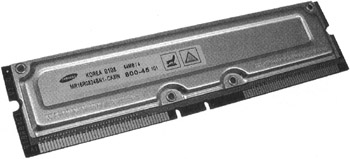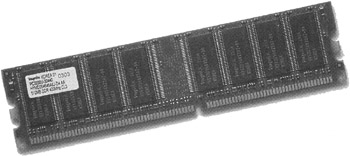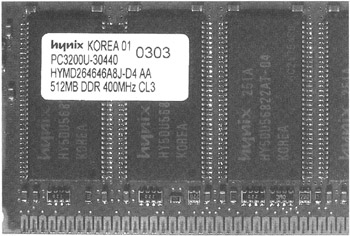Random Access Memory
|
| < Day Day Up > |
|
Computer performance depends not only on the internal CPU speed of data processing, but also on the rate of information exchange with other PC components.
Bandwidth
Data exchange is accomplished via special buses, the main characteristic of which is bandwidth. This key parameter determines the throughput, which depends on the clock frequency of the bus, the number of packets sent per clock, and the bus width. This dependence looks as follows:
Throughput = Clock frequency × Number of packets × Bus width
Maximum performance is achieved when the processor bus and the memory bus have matching bandwidths. Depending on the processor, this imposes stringent limitations on the memory subsystem architecture and the type of the modules used in the configuration.
SDRAM Modules
Synchronous Dynamic Random Access Memory (SDRAM) has long been the main type of memory used in computers. Operation of this memory is synchronized using an external signal. This is reflected by the name of this memory (Fig. 4.21).

Figure 4.21: SDRAM module
Remember that the memory subsystem interacts with all other components via the appropriate chip of the chipset. Because of this, operation is synchronized with the chipset, rather than with the processor. This means that the processor bus and the main-memory bus can have the same clock frequencies and operate in synchronous mode, or different frequencies and operate in asynchronous mode. Note that even when operating in asynchronous mode, RAM, by its type and by its operating principles, remains synchronous memory: SDRAM.
SDRAM modules are designed to work at 66 MHz, 100 MHz, or 133 MHz. Accordingly, memory modules are marked PC66, PC100, or PC133. These modules, manufactured as Dual In-line Memory Modules (DIMM), have 168 pins and are intended for a supply voltage of 3.3 V. Memory modules are connected via a 64-bit memory bus.
Such modules ensure different performance levels of the RAM subsystem. To achieve maximum performance, it is necessary to choose the memory module variant appropriate for the processor bus clock frequency.
The values of the processor and memory bus throughput are listed in Table 4.24. They depend on the type of CPU and SDRAM modules.
| Processor/SDRAM module | Bus clock frequency (MHz) | Number of packets on the bus | Bus width (bytes) | Bus bandwidth (GB/sec) |
|---|---|---|---|---|
| Intel Celeron | 66/100 | 1 | 8 | 0.5/0.8 |
| Intel Pentium II/III | 66/100/133 | 1 | 8 | 0.5/0.8/1.0 |
| AMD Duron | 100 | 2 | 8 | 1.6 |
| AMD Athlon | 100/133 | 2 | 8 | 1.6/2.1 |
| Intel Pentium 4 | 100/133/200 | 4 | 8 | 3.2/4.2/6.4 |
| AMD Athlon XP | 100/133/166/200 | 2 | 8 | 1.6/2.1/2.7/3.2 |
| PC66/100/133 | 66/100/133 | 1 | 8 | 0.5/0.8/1.0 |
As follows from Table 4.24, balance between the bandwidths of the FSB frequency and the memory-bus frequency is ensured only for Intel Celeron, Pentium II, and Pentium III. For all other processors, the FSB throughput in this mode exceeds the similar parameter of the memory bus. The same situation applies to asynchronous modes. Although configurations with SDRAM are common, this type of memory cannot reach the maximal performance level on powerful processors with high FSB frequencies. For these configurations, more advanced types of RAM are preferable.
Direct RDRAM Modules
Steady growth of processor performance and improvements in manufacturing technologies stimulate the development of new types of RAM. Direct Rambus DRAM (DRDRAM or Direct RDRAM), developed by Rambus and supported by Intel, became one such innovation (Fig. 4.22).

Figure 4.22: RIMM module
The release of Direct RDRAM required new packaging for memory modules. The Direct RDRAM chips are assembled into RIMM modules, similar in appearance to the standard DIMM.
RIMM modules can be used on motherboards with standard form factors such as ATX. However, RIMM modules can be used only in systems whose BIOS and chipset both support Direct RDRAM. For example, specialized chipsets from Intel, including i820, i850, and their modifications, provide this support.
The architecture of the Direct RDRAM subsystem gives provisions for up to four channels (buses). Each bus is 16 bits (18 bits, if Error Correction Code (ECC) support is provided). Data transmission takes place at high clock frequencies on both fronts of the clock pulse. This data rate is usually specified in the model marking. (It is twice the channel clock frequency).
For the systems based on Intel Pentium III processors and i820/820E chipsets, single-channel versions are used. In this case, the channel clock frequency can be up to 400 MHz, and the data-transmission rate can be up to 800 MHz. Three types of RIMM modules are used: PC600 for the clock frequency up to 300 MHz and the data rate up to 600 MHz, PC700 for the clock frequency up to 356 MHz and the data rate of 712 MHz, and PC800 for the clock frequency up to 400 MHz and the data rate of 800 MHz. When using PC800 modules, the bandwidth is 1.6 GB/sec.
For systems based on Intel Pentium 4 processors and 850/850E chipsets, dual-channel variants are used. In this case, the channel clock frequency is 400/533 MHz, and the data-transfer rate is 800/1,066 MHz. PC800 and PC1066 RIMM are used as memory modules. The bandwidth of a dual-channel variant using PC1066 modules is 4.2 GB/sec.
From the data provided in Table 4.25, it follows that a single-channel Direct RDRAM variant is sufficient for Pentium III, because the channel bandwidth even exceeds that of the processor bus. For configurations based on Pentium 4, the dual-channel variant is optimal.
| Processor/Direct RDRAM module | Bus clock frequency (MHz) | Number of packets on the bus | Bus width (bytes) | Bus bandwidth (GB/sec) |
|---|---|---|---|---|
| Intel Pentium III | 100/133 | 1 | 8 | 0.8/1.0 |
| Intel Pentium 4 | 100/133 | 4 | 8 | 3.2/4.2 |
| Single PC800/1066 channel | 400/533 | 2 | 2 | 1.6/2.1 |
| Two PC800/1066 channels | 400/533 | 2 | 2 | 3.2/4.2 |
When discussing specific features of RIMM modules, it is necessary to point out that they require intensive cooling. This relates to high power consumption and, consequently, intensive heat emission. These are caused by the high clock frequency of the memory chips.
Despite the high performance of the dual-channel variant, this configuration is not widely used because of the cost of RIMM modules: both the high manufacturing expenses and the license payment due to Rambus.
The future of RIMM modules depends on advances in the development of alternative types of memory, such as DDR SDRAM.
DDR SDRAM
Double Data Rate SDRAM (DDR SDRAM, or simply DDR) is an alternative to Direct RDRAM. This type of memory is the next step in the evolution of SDRAM. DDR SDRAM, like SDRAM, is synchronous memory. However, in contrast to SDRAM, DDR SDRAM data transmission takes place on both fronts of the clock pulse. SDRAM often is referred to as SDR SDRAM (Single Data Rate SDRAM).
Data transmission on both fronts of the clock pulse doubles the bandwidth.
DDR SDRAM modules are intended for clock frequencies of 100 MHz, 133 MHz, 166 MHz, and 200 MHz (Fig. 2.23). These modules are marked with their data rate: DDR200, DDR266, DDR333, and DDR400.

Figure 4.23: DDR SDRAM module
Besides the data rate, the marking of DDR SDRAM modules includes bandwidth values. Thus, these memory modules are marked as PC1600, PC2100, PC2700, and PC3200 (Fig. 4.24).

Figure 4.24: Fragment of the PC3200 (DDR400) module
DDR SDRAM modules are manufactured in the DIMM form factor. They have 184 pins and are intended for a supply voltage of 2.5 V. These modules are connected using a 64-bit memory bus.
DDR SDRAM modules can be used in systems whose BIOS and chipset support this memory type. Such chipsets include i845 from Intel and Apollo KT400 from Via Technologies.
As with Direct RDRAM, dual-channel variants of DDR SDRAM are designed and implemented for high-performance systems. This doubles the memory subsystem throughput. Specialized chipsets that support a dual-channel memory subsystem include the i875 and i865 lines from Intel. Via Technologies and SIS have released similar chipset lines.
DDR200, DDR266, DDR333, and DDR400 modules ensure different performance qualities of the memory subsystem. To achieve maximum computer performance, depending on the processor bus frequency, it is necessary to choose the appropriate DDR SDRAM module.
The values of the bandwidths of the processor and memory buses, depending on the processor and DDR SDRAM module used in hardware configuration, are listed in Table 4.26.
| Processor/DDR SDRAM module | Bus clock frequency (MHz) | Number of packets on the bus | Bus width (bytes) | Bus bandwidth (GB/sec) |
|---|---|---|---|---|
| Intel Celeron | 66/100 | 1 | 8 | 0.5/0.8 |
| Intel Pentium II/III | 66/100/133 | 1 | 8 | 0.5/0.8/1.0 |
| AMD Duron | 100 | 2 | 8 | 1.6 |
| AMD Athlon | 100/133 | 2 | 8 | 1.6/2.1 |
| Intel Pentium 4 | 100/133/200 | 4 | 8 | 3.2/4.2/6.4 |
| AMD Athlon XP | 100/133/166/200 | 2 | 8 | 1.6/2.1/2.7/3.2 |
| Single-channel DDR 200/266/333/400 | 100/133/166/400 | 2 | 8 | 1.6/2.1/2.7/3.2 |
| Dual-channel DDR 200/266/333/400 | 100/133/166/400 | 2 | 8 | 3.2/4.2/5.4/6.4 |
From the data provided in Table 4.26, it follows that for configurations based on Intel and AMD processors, it is possible to create well-balanced variants of the memory subsystem based on DDR SDRAM.
|
| < Day Day Up > |
|
EAN: 2147483647
Pages: 111